| Srl | Item |
| 1 |
ID:
132460
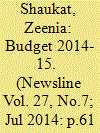

|
|
|
|
|
| Publication |
2014.
|
| Summary/Abstract |
This year's budget presented by the PML-N has been centred around economic growth.The question is whether this growth will be achieved at the expense of the masses.
|
|
|
|
|
|
|
|
|
|
|
|
|
|
|
|
| 2 |
ID:
118290
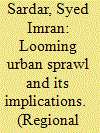

|
|
|
| 3 |
ID:
076899


|
|
|
|
|
| Publication |
2007.
|
| Summary/Abstract |
In 2001 China ratified the International Covenant on Economic, Social and Cultural Rights. By so doing the national government became legally bound, "to the maximum of its available resources", to achieve "progressively" full realization of the rights specified in the Covenant. Included amongst these entitlements is the "right of everyone to social security, including social insurance". This paper uses data from Jiangsu to examine the extent to which urbanites agree that previously disenfranchised migrants have the same right to social insurance as the urban population. Many urbanites fear that their existing entitlements to social protection will be diluted if social insurance coverage is extended to include new populations. Accordingly, state agencies and the media have sought to promote acceptance of a more positive view of migrant workers than has traditionally prevailed within towns and cities. We find that younger urban residents, urban residents who already have social insurance and urban residents working in the state-owned sector are more likely to agree that migrants have the same right to social insurance as the urban population.
|
|
|
|
|
|
|
|
|
|
|
|
|
|
|
|
| 4 |
ID:
112102
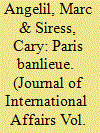

|
|
|
|
|
| Publication |
2012.
|
| Summary/Abstract |
Debates on contemporary urban conditions often center on the periphery of the city where an ever-increasing proportion of the urban population is forced to live. This article focuses on the banlieue-the periphery of Paris-as a model for the breakdown of the spatial order in cities globally. We examine how France's urban planning, guided by political and economic influences, has created and sustained banlieue poverty and marginalization. With rising anxieties about civil disorder in Paris resulting from the spatial inequities and cultural stigma toward the banlieue, it is now generally agreed that the city's historical planning policies have failed. We argue that any attempt to allocate space within a city equitably cannot emanate from the city center alone, but must also come from the marginalized periphery, which is equally a part of the system.
|
|
|
|
|
|
|
|
|
|
|
|
|
|
|
|
| 5 |
ID:
126244


|
|
|
|
|
| Publication |
2012.
|
| Summary/Abstract |
Recent national plans for recovery from bioterrorism acts perpetrated in densely populated urban areas acknowledge the formidable technical and social challenges of consequence management. Effective risk and crisis communication is one priority to strengthen the U.S.'s response and resilience. However, several notable risk events since September 11, 2001, have revealed vulnerabilities in risk/crisis communication strategies and infrastructure of agencies responsible for protecting civilian populations. During recovery from a significant biocontamination event, 2 goals are essential: (1) effective communication of changing risk circumstances and uncertainties related to cleanup, restoration, and reoccupancy; and (2) adequate responsiveness to emerging information needs and priorities of diverse populations in high-threat, vulnerable locations. This telephone survey study explored predictors of public reactions to uncertainty communications and reassurances from leaders related to the remediation stage of an urban-based bioterrorism incident. African American and Hispanic adults (N=320) were randomly sampled from 2 ethnically and socioeconomically diverse geographic areas in New York and California assessed as high threat, high vulnerability for terrorism and other public health emergencies. Results suggest that considerable heterogeneity exists in risk perspectives and information needs within certain sociodemographic groups; that success of risk/crisis communication during recovery is likely to be uneven; that common assumptions about public responsiveness to particular risk communications need further consideration; and that communication effectiveness depends partly on preexisting values and risk perceptions and prior trust in leaders. Needed improvements in communication strategies are possible with recognition of where individuals start as a reference point for reasoning about risk information, and comprehension of how this influences subsequent interpretation of agencies' actions and communications.
|
|
|
|
|
|
|
|
|
|
|
|
|
|
|
|
| 6 |
ID:
110015
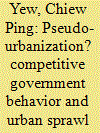

|
|
|
|
|
| Publication |
2012.
|
| Summary/Abstract |
Urban population size is a slippery indicator of China's urbanization level. Urban sprawl through infrastructure construction, the setting up of development zones and administrative adjustments, expands urban space and in turn inflates urban population size without necessarily urbanizing the overall landscape or economy. This article seeks to distinguish urbanization from urban sprawl. It aims to uncover why and how local governments have spurred urban sprawl and shaped urbanization in today's China. It suggests that urban sprawl is a land-centered process engineered by the government primarily to generate revenue for local coffers. City building has become a competitive enterprise for local governments who seek to outdo each other in 'place-making', both to attract investments and to conjure up highly visible trophy projects. The implications of these findings on China's urbanization and how urban sprawl may be further studied are addressed at the end of the article.
|
|
|
|
|
|
|
|
|
|
|
|
|
|
|
|
| 7 |
ID:
102447
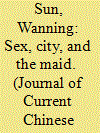

|
|
|
|
|
| Publication |
2010.
|
| Summary/Abstract |
Of the many rural migrant workers who go to Chinese cities as cheap labourers, the one who interacts most intimately with urban residents is the domestic servant. In fact, precisely because of this "intimate stranger" status, the figure of the "maid" has captured the imagination of the urban population. This fascination is evidenced by the plethora of television narratives centring on the fraught relationships between the rural migrant woman and her male employer. This paper analyses a range of television narratives from the genres of dramas and documentaries. It shows that in these narratives, sex functions as the metaphor of social inequality between two social groups. It shows that if we explore how love, romance and marriage are constructed, we may gain some insight into processes of social and ideological contestation in the domain of cultural production.
|
|
|
|
|
|
|
|
|
|
|
|
|
|
|
|